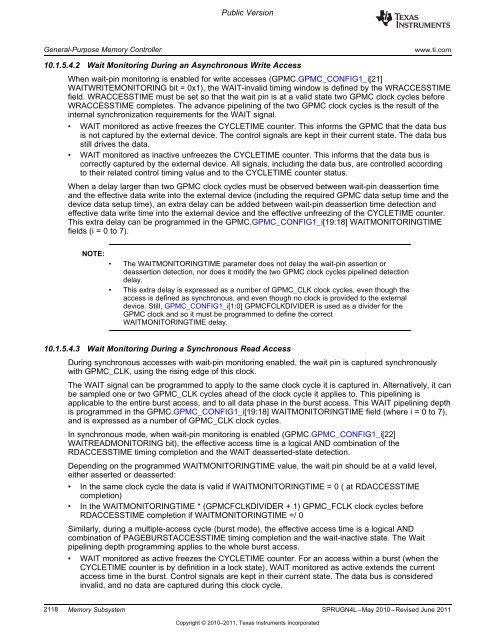Chapter 10 Memory Subsystem.pdf
Chapter 10 Memory Subsystem.pdf
Chapter 10 Memory Subsystem.pdf
You also want an ePaper? Increase the reach of your titles
YUMPU automatically turns print PDFs into web optimized ePapers that Google loves.
Public Version<br />
General-Purpose <strong>Memory</strong> Controller www.ti.com<br />
<strong>10</strong>.1.5.4.2 Wait Monitoring During an Asynchronous Write Access<br />
When wait-pin monitoring is enabled for write accesses (GPMC.GPMC_CONFIG1_i[21]<br />
WAITWRITEMONITORING bit = 0x1), the WAIT-invalid timing window is defined by the WRACCESSTIME<br />
field. WRACCESSTIME must be set so that the wait pin is at a valid state two GPMC clock cycles before<br />
WRACCESSTIME completes. The advance pipelining of the two GPMC clock cycles is the result of the<br />
internal synchronization requirements for the WAIT signal.<br />
• WAIT monitored as active freezes the CYCLETIME counter. This informs the GPMC that the data bus<br />
is not captured by the external device. The control signals are kept in their current state. The data bus<br />
still drives the data.<br />
• WAIT monitored as inactive unfreezes the CYCLETIME counter. This informs that the data bus is<br />
correctly captured by the external device. All signals, including the data bus, are controlled according<br />
to their related control timing value and to the CYCLETIME counter status.<br />
When a delay larger than two GPMC clock cycles must be observed between wait-pin deassertion time<br />
and the effective data write into the external device (including the required GPMC data setup time and the<br />
device data setup time), an extra delay can be added between wait-pin deassertion time detection and<br />
effective data write time into the external device and the effective unfreezing of the CYCLETIME counter.<br />
This extra delay can be programmed in the GPMC.GPMC_CONFIG1_i[19:18] WAITMONITORINGTIME<br />
fields (i = 0 to 7).<br />
NOTE:<br />
• The WAITMONITORINGTIME parameter does not delay the wait-pin assertion or<br />
deassertion detection, nor does it modify the two GPMC clock cycles pipelined detection<br />
delay.<br />
• This extra delay is expressed as a number of GPMC_CLK clock cycles, even though the<br />
access is defined as synchronous, and even though no clock is provided to the external<br />
device. Still, GPMC_CONFIG1_i[1:0] GPMCFCLKDIVIDER is used as a divider for the<br />
GPMC clock and so it must be programmed to define the correct<br />
WAITMONITORINGTIME delay.<br />
<strong>10</strong>.1.5.4.3 Wait Monitoring During a Synchronous Read Access<br />
During synchronous accesses with wait-pin monitoring enabled, the wait pin is captured synchronously<br />
with GPMC_CLK, using the rising edge of this clock.<br />
The WAIT signal can be programmed to apply to the same clock cycle it is captured in. Alternatively, it can<br />
be sampled one or two GPMC_CLK cycles ahead of the clock cycle it applies to. This pipelining is<br />
applicable to the entire burst access, and to all data phase in the burst access. This WAIT pipelining depth<br />
is programmed in the GPMC.GPMC_CONFIG1_i[19:18] WAITMONITORINGTIME field (where i = 0 to 7),<br />
and is expressed as a number of GPMC_CLK clock cycles.<br />
In synchronous mode, when wait-pin monitoring is enabled (GPMC.GPMC_CONFIG1_i[22]<br />
WAITREADMONITORING bit), the effective access time is a logical AND combination of the<br />
RDACCESSTIME timing completion and the WAIT deasserted-state detection.<br />
Depending on the programmed WAITMONITORINGTIME value, the wait pin should be at a valid level,<br />
either asserted or deasserted:<br />
• In the same clock cycle the data is valid if WAITMONITORINGTIME = 0 ( at RDACCESSTIME<br />
completion)<br />
• In the WAITMONITORINGTIME * (GPMCFCLKDIVIDER + 1) GPMC_FCLK clock cycles before<br />
RDACCESSTIME completion if WAITMONITORINGTIME =/ 0<br />
Similarly, during a multiple-access cycle (burst mode), the effective access time is a logical AND<br />
combination of PAGEBURSTACCESSTIME timing completion and the wait-inactive state. The Wait<br />
pipelining depth programming applies to the whole burst access.<br />
• WAIT monitored as active freezes the CYCLETIME counter. For an access within a burst (when the<br />
CYCLETIME counter is by definition in a lock state), WAIT monitored as active extends the current<br />
access time in the burst. Control signals are kept in their current state. The data bus is considered<br />
invalid, and no data are captured during this clock cycle.<br />
2118 <strong>Memory</strong> <strong>Subsystem</strong> SPRUGN4L–May 20<strong>10</strong>–Revised June 2011<br />
Copyright © 20<strong>10</strong>–2011, Texas Instruments Incorporated

















